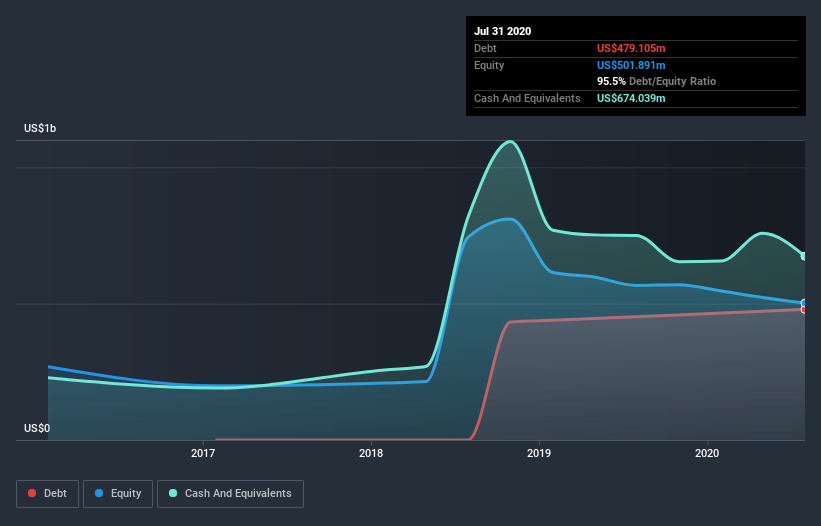DocuSign (NASDAQ:DOCU) Has Debt But No Earnings; Should You Worry?

The external fund manager backed by Berkshire Hathaway's Charlie Munger, Li Lu, makes no bones about it when he says 'The biggest investment risk is not the volatility of prices, but whether you will suffer a permanent loss of capital.' It's only natural to consider a company's balance sheet when you examine how risky it is, since debt is often involved when a business collapses. We can see that DocuSign, Inc. (NASDAQ:DOCU) does use debt in its business. But is this debt a concern to shareholders?
When Is Debt Dangerous?
Debt and other liabilities become risky for a business when it cannot easily fulfill those obligations, either with free cash flow or by raising capital at an attractive price. Part and parcel of capitalism is the process of 'creative destruction' where failed businesses are mercilessly liquidated by their bankers. However, a more usual (but still expensive) situation is where a company must dilute shareholders at a cheap share price simply to get debt under control. Of course, debt can be an important tool in businesses, particularly capital heavy businesses. The first thing to do when considering how much debt a business uses is to look at its cash and debt together.
See our latest analysis for DocuSign
What Is DocuSign's Debt?
As you can see below, at the end of July 2020, DocuSign had US$479.1m of debt, up from US$451.9m a year ago. Click the image for more detail. However, it does have US$674.0m in cash offsetting this, leading to net cash of US$194.9m.
How Healthy Is DocuSign's Balance Sheet?
Zooming in on the latest balance sheet data, we can see that DocuSign had liabilities of US$854.0m due within 12 months and liabilities of US$697.4m due beyond that. Offsetting this, it had US$674.0m in cash and US$241.5m in receivables that were due within 12 months. So its liabilities outweigh the sum of its cash and (near-term) receivables by US$635.8m.
Having regard to DocuSign's size, it seems that its liquid assets are well balanced with its total liabilities. So while it's hard to imagine that the US$42.9b company is struggling for cash, we still think it's worth monitoring its balance sheet. Despite its noteworthy liabilities, DocuSign boasts net cash, so it's fair to say it does not have a heavy debt load! There's no doubt that we learn most about debt from the balance sheet. But ultimately the future profitability of the business will decide if DocuSign can strengthen its balance sheet over time. So if you want to see what the professionals think, you might find this free report on analyst profit forecasts to be interesting.
Over 12 months, DocuSign reported revenue of US$1.2b, which is a gain of 40%, although it did not report any earnings before interest and tax. Shareholders probably have their fingers crossed that it can grow its way to profits.
So How Risky Is DocuSign?
Although DocuSign had an earnings before interest and tax (EBIT) loss over the last twelve months, it generated positive free cash flow of US$134m. So although it is loss-making, it doesn't seem to have too much near-term balance sheet risk, keeping in mind the net cash. The good news for DocuSign shareholders is that its revenue growth is strong, making it easier to raise capital if need be. But that doesn't change our opinion that the stock is risky. When analysing debt levels, the balance sheet is the obvious place to start. But ultimately, every company can contain risks that exist outside of the balance sheet. Be aware that DocuSign is showing 3 warning signs in our investment analysis , you should know about...
If, after all that, you're more interested in a fast growing company with a rock-solid balance sheet, then check out our list of net cash growth stocks without delay.
This article by Simply Wall St is general in nature. It does not constitute a recommendation to buy or sell any stock, and does not take account of your objectives, or your financial situation. We aim to bring you long-term focused analysis driven by fundamental data. Note that our analysis may not factor in the latest price-sensitive company announcements or qualitative material. Simply Wall St has no position in any stocks mentioned.
Have feedback on this article? Concerned about the content? Get in touch with us directly. Alternatively, email editorial-team@simplywallst.com.

